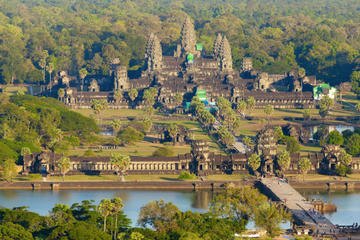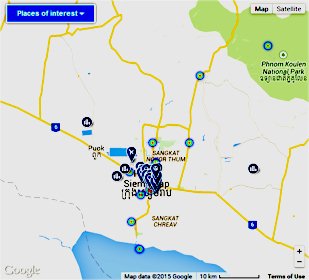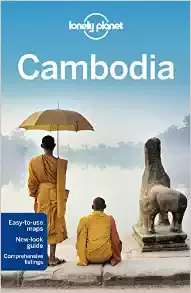« Home • Asia & Pacific • CAMBODIA • Discover Cambodia • Angkor Wat
Discover magical Angkor Wat

Angkor Wat is a Hindu temple complex at Angkor, Cambodia, built for the king Suryavarman II in the early 12th century as his state temple and capital city. As the best-preserved temple at the site, it is the only one to have remained a significant religious centre since its foundation - first Hindu then Buddhist.
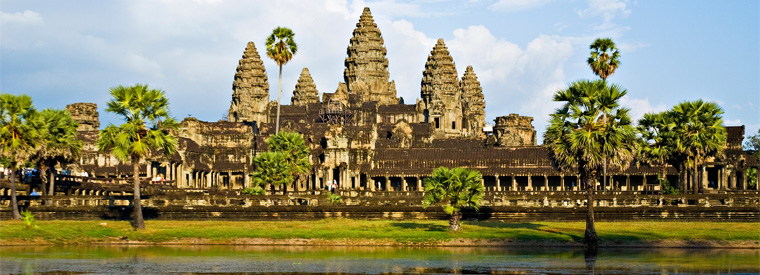
A | B | C | D | E | F | G | H | I | J | K | L | M | N | O | P | Q | R | S | T | U | V | W | X | Y | Z
» Angkor Thom
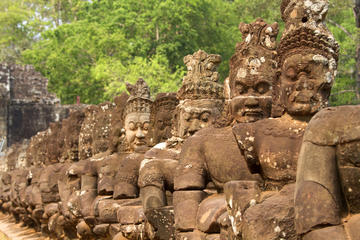
The last capital of the Khmers is a stupendous complex on a stupefying scale; established in the 12th century on the site of an earlier capital, Angkor Thom dwarfs even nearby Angkor Wat. The city's 7.5 miles (12 kilometers) of wall is ringed by a moat (which no longer holds water or - thankfully - crocodiles). Each of the five enormous gates is a monument in itself, approached by avenues lined with 108 divinities (good on the left, evil on the right) …
» Angkor Wat
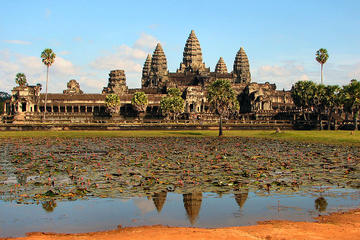
For many people, Angkor Wat alone justifies a trip to Southeast Asia. Like many sites in the Angkor Archeological Park, this breathtaking temple dates to the 12th century, with its unique west-facing orientation indicating that it was intended as a mausoleum for its creator, Suryavarman II. Angkor Wat's colossal size reflects its ambition: this was intended as no less than a microcosm of the universe. Nonetheless it's difficult to get lost here …
» Bakong
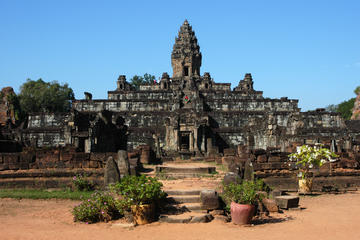
One of the earliest temples in the region, Bakong was built in tiers within a strict geometric matrix, a style recognizable in the later Angkor Wat. Though significantly smaller than that complex, Bakong has a charm all its own. The central temple rises on 5 tiers and was dedicated to the Hindu god Shiva. It dates to 881 AD, though the tower which forms its focal point was added much later …
» Banteay Kdei
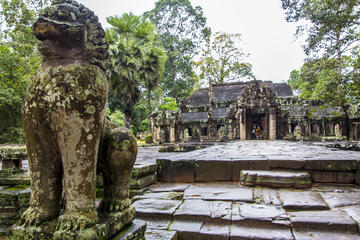
The unrestored ruins of Banteay Kdei, a Buddhist monastery complex, date back to 1181. This was one of the first structures built by the prolific King Jayavarman VII, and it features four gates, each adorned with a carved face of the king, much like at Bayon. One of the first things you'll notice upon visiting Banteay Kdei is the way its walls and structures lean precariously, some held up by ropes and cables. Banteay Kdei was made from softer gray sandstone that has eroded over time …
» Banteay Srei
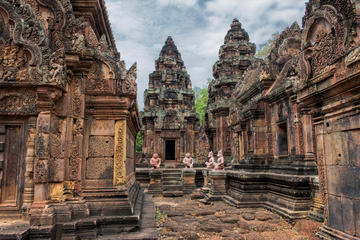
Located 24 miles (38 km) northeast of Siem Reap, the Hindu temple of Banteay Srei lies off the beaten tourist path in Angkor but is a must-see for temple buffs. While small by Angkor standards, the 10-century red sandstone structure is famous for its intricate and well-preserved decorative carvings. French archaeologists who uncovered it during the early 20th century called it 'a jewel in Khmer art.' …
» Baphoun
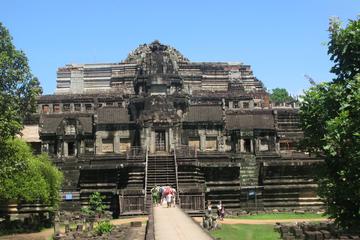
Baphuon began life in the 11th century as a Hindu temple meant to represent mystical Mount Meru, like most temples in the region. It was later rededicated to Buddha but hasn't weathered the intervening years as well as its neighbors, with much of the construction lying in countless pieces. A vast reclining Buddha forms a wall of one of the temple's three tiers, but you will have to exercise your imagination to visualize the divinity's features …
» Bayon Temple
The Bayon temple forms a square at the center of the much larger square of the vast Angkor Thom, and is the architectural highlight of the complex. This was considered by the Khmers to be the conjunction of heaven and earth, though the auspicious site was covered in jungle for centuries. Like much in the area it dates to the 12th-century reign of King Jayavarman VII, and is particularly noted for its magnificent carved stone faces with their beatific smiles …
» Phimeanakas
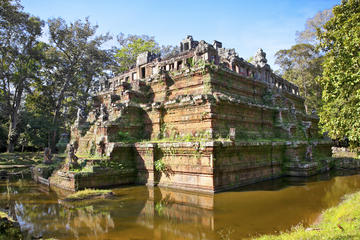
Set near the center of the Royal Enclosure in Angkor Thom, Phimeanakas served as the king's personal temple during the 10th and 11th centuries, before Jayavarman VII constructed Angkor Thom around it. Historians believe the three-tiered temple was once topped with a gold-covered tower, but very little of it remains. According to local legend, the king would visit the top of the temple each night to meet a woman with the head of a naga (a serpent deity) …
» Phnom Bakheng
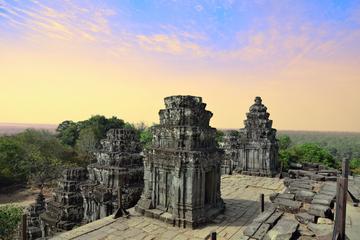
Built during the ninth century at what was the center of the royal city at the time, Phnom Bakheng (also known as the temple of Shiva) is one of the oldest temples in Angkor. The five-tiered pyramidal structure, built on top of a hill, and was originally surrounded by 108 towers, an auspicious number in many Eastern religions. While the temple ruins of Phnom Bakheng are impressive, the reason most visitors come is to watch the sunset from the top …
» Preah Khan
Preah Khan was built around the same time as Angkor Thom, and like it was conceived as a whole city, though on a smaller scale. It was erected on the site of an important military victory and its outer perimeter is guarded by 72 stone garudas (winged mythological creatures depicted throughout Southeast Asia). A stupa (a domed structure holding Buddhist relics) and numerous smaller Hindu temples indicate the spiritual mix that Preah Khan embodied …
» Pre Rup
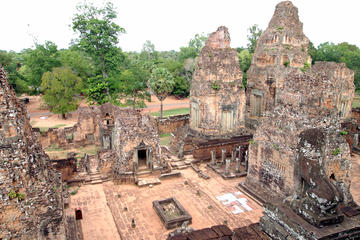
Built in 961 by King Rajendravarman II, the three-spired Shiva temple of Pre Rup resembles Angkor Wat on a smaller scale. The name of the temple translates to 'turning the body,' suggesting that it might have once served as a crematorium for Angkor's royalty. Built a few years after nearby Mebon but identical to it in architectural style, Pre Rup was made from gray sandstone, once coated in a layer of plaster that has largely worn away …
» Roluos Group
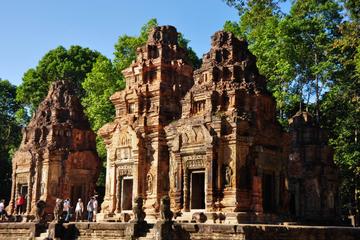
The 3 main temples of Roluos stand apart from the main attractions around Siem Reap, lying to the west of the town rather than on the main northern axis. They're also significantly older, dating from the 9th century when this area was known as Hariharalaya. Preah Ko, the oldest, is arranged as two rows of three "prasats" (towers) each, and boasts stunning stone carvings and plasterwork. After that comes the intricate 5-tiered Bakong, and finally Lolei, which dates from 893 …
» Royal Enclosure
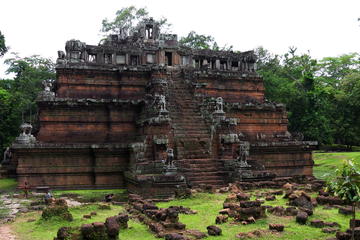
Just to the northwest of the center of Angkor Tom lies one of the Angkor Wat region's more mysterious ruins, the Royal Enclosure. All that remains of this ancient royal abode (the home of kings during the 10th and 11th centuries) is its surrounding walls and a pair of stone-lined bathing pools. Historians believe the lack of any other archaeological evidence suggests the royal palace itself was constructed of wood …
» Siem Reap
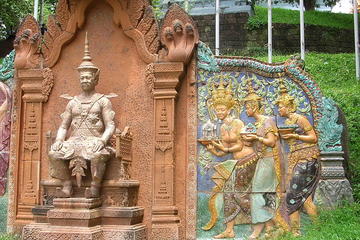
Siem Reap is the gateway to the incomparable treasures of the Angkor Archeological Park, but when temple fatigue hits this bustling town has its own charms. Chinese and French influence is reflected in the older parts of the town. Psar Chaa market is the best place to head for Cambodian cuisine, while the flavors available elsewhere range from authentic to a taste of home for long-term backpackers. A visit to the mangrove swamps and bird sanctuaries …
» Srah Srang
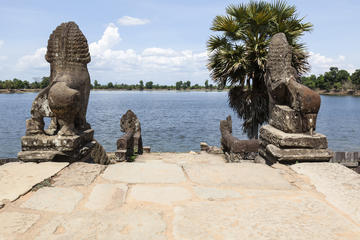
Srah Srang is a baray, or reservoir, that is located south of the East Baray and east of Banteay Kde. Srah Srang was created by excavation in the mid-900s and, while there are several theories, it's not clear whether the significance of this reservoir was religious, agricultural or a little bit of both. However, Srah Srang is best known as an ideal location for viewing the sunrise. At present Srah Srang measures almost 2,300 feet by almost 1,200 feet and is still partially flooded …
» Ta Prohm
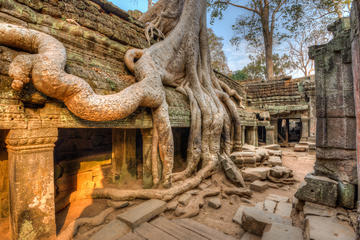
When the temples of Angkor were abandoned by the kings who built them, the jungle took firm hold of Ta Prohm. This Buddhist monastery, built in 1186 by King Jayavarman VII for his mother, today looks much like it did when it was uncovered in the 29th century. In eerie fashion, giant trees shoot through the tops of structures, while thick vines split walls in two. A favorite among visitors, Ta Prohm served as the backdrop for Lara Croft's adventures in the film Tomb Raider …
» Terrace of the Elephants
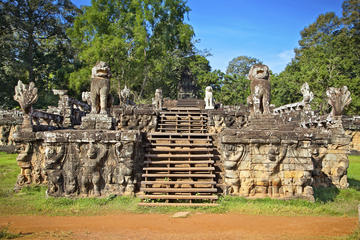
Located within the ancient walled city of Angkor Thom, the Terrace of the Elephants stretches across a grassy expanse for nearly 1,150 feet (350 meters) and once served as a ceremonial platform and foundation for the king's royal audience hall. The ornately carved Terrace of the Elephants, built near the end of the 12th century by King Jayavarman VII, gets its name from the relief stone carvings of parading elephants that adorn the terrace walls …
» Terrace of the Leper King
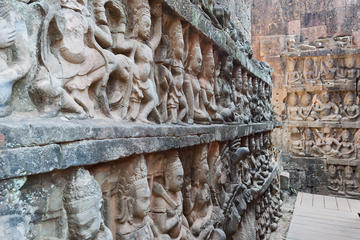
One of Angkor's many mysteries, the Terrace of the Leper King once served as the northern half of a long viewing stage and audience platform for King Jayavarman VII and his entourage. The mystery of the site stems from the statue at the top of the terrace, a replica of an original statue of a nude, sexless figure known simply as the Leper King. Scholars aren't sure who he was, though legend tells of at least two kings of Angkor having leprosy …
» Wat Athvea (Prasat Vat Althea)
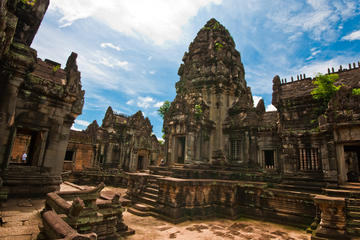
Believed to have been built during King Suryavarman II's reign in the first half of the 12th century, Wat Athvea (Prasat Vat Althea) is one of several Hindu temples in the area shrouded in mystery. Built from laterite and sandstone, both still in relatively good condition, the temple has no inscriptions and few carvings. It seems as though the carvings it does were abandoned before they were completed …
» Wat Preah Prom Rath
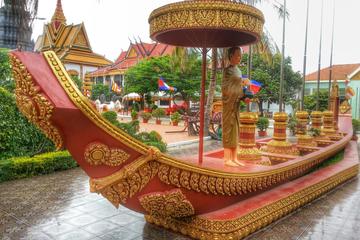
Though it's more than 500 years old, Wat Preah Prom Rath is a modern-looking temple and monastery located in the heart of Siem Reap. The front gate is the perhaps the oldest looking piece of the site, with Bayon style carvings that are similar to the ones found in Angkor Wat. The temple grounds are large, home to a university building as well as the main hall. However, the main attraction is the reclining Buddha-which is now sinking as well as reclining- …
« Home • Asia & Pacific • CAMBODIA • Discover Cambodia • Angkor Wat



